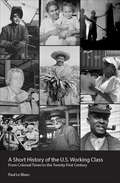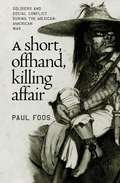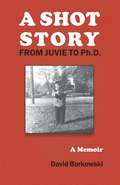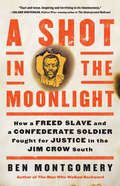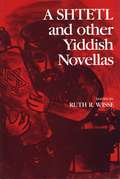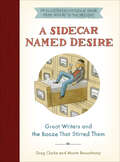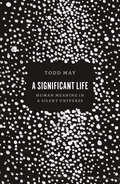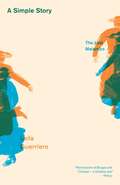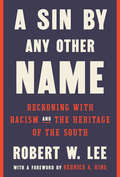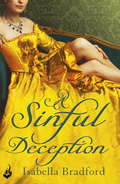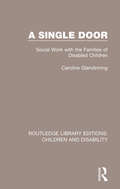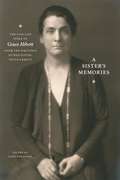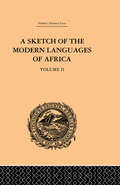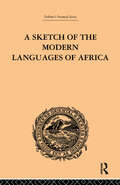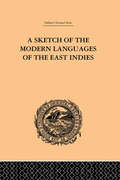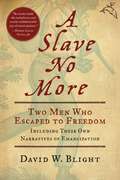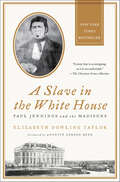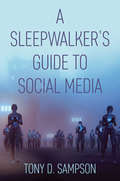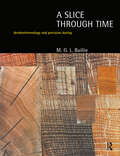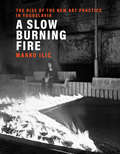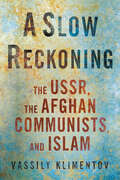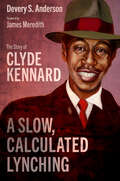- Table View
- List View
A Short History of the U.S. Working Class: From Colonial Times to the Twenty-First Century (Revolutionary Studies)
by Paul Le Blanc&“His aim is to make the history of labor in the U.S. more accessible to students and the general reader. He succeeds&” (Booklist). In a blend of economic, social, and political history, Paul Le Blanc shows how important labor issues have been, and continue to be, in the forging of our nation. Within a broad analytical framework, he highlights issues of class, gender, race, and ethnicity, and includes the views of key figures of United States labor. The result is a thought-provoking look at centuries of American history from a perspective that is too often ignored or forgotten. &“An excellent overview, enhanced by a valuable glossary.&” —Elaine Bernard, director of the Harvard Trade Union Program
A Short Introduction to Attachment and Attachment Disorder, Second Edition
by Colby PearceConcise and easy-to-understand, this book provides an introduction to what attachment means and how to recognise attachment disorder in children. Colby Pearce explains how complex problems in childhood may stem from the parent-child relationship during a child's early formative years, and later from the child's engagement with the broader social world. The book explores the mind-set of difficult and traumatised children and the motivations behind their complex tendencies and behaviours. It goes on to offer a comprehensive set of tried-and-tested practical strategies that can be used with children affected by an attachment disorder. This second edition has been updated to include the new DSM-5 diagnostic criteria for Reactive Attachment Disorder and an increased number of illustrative case vignettes. This is a perfect introduction to the subject for parents, carers and practitioners in supportive roles caring for children.
A Short, Offhand, Killing Affair
by Paul FoosThe Mexican-American War (1846-48) found Americans on new terrain. A republic founded on the principle of armed defense of freedom was now going to war on behalf of Manifest Destiny, seeking to conquer an unfamiliar nation and people. Through an examination of rank-and-file soldiers, Paul Foos sheds new light on the war and its effect on attitudes toward other races and nationalities that stood in the way of American expansionism.Drawing on wartime diaries and letters not previously examined by scholars, Foos shows that the experience of soldiers in the war differed radically from the positive, patriotic image trumpeted by political and military leaders seeking recruits for a volunteer army. Promised access to land, economic opportunity, and political equality, the enlistees instead found themselves subjected to unusually harsh discipline and harrowing battle conditions. As a result, some soldiers adapted the rhetoric of Manifest Destiny to their own purposes, taking for themselves what had been promised, often by looting the Mexican countryside or committing racial and sexual atrocities. Others deserted the army to fight for the enemy or seek employment in the West. These acts, Foos argues, along with the government's tacit acceptance of them, translated into a more violent, damaging variety of Manifest Destiny.
A Shot Story: From Juvie to Ph.D.
by David BorkowskiThe botched robbery didn’t do it. Neither did the three gunshots. It wasn’t until he was administered last rites that David Borkowski realized he was about to die, at age fifteen. A Shot Story: From Juvie to Ph.D. is a riveting account of how being shot saved his life and helped a juvenile delinquent become an esteemed English professor.Growing up in a working-class section of Staten Island, David and his friends thought they had all the answers: They knew where to hang out without being hassled, where to get high, and what to do if the cops showed up. But when David and his friend called in a pizza order so they could rob the delivery man, things didn’t turn out as they’d planned. Staring down the barrel of a gun, David and his friend panicked and took off as the cop fired. Convinced the cop was shooting harmless “salt” bullets, David darted through lawns as the cop gave chase. Much later, when David was bleeding to death, did the cops realize they had hit one of their own—the son of a fellow cop.Borderline illiterate at the time of the shooting, David took his future into his own hands and found salvation in books. But his attempts to improve his life were stymied by lack of familial support. Bound on all sides by adults who had no faith in his ability to learn or to succeed, David persevered and earned his Ph.D..Funny and poignant, but always honest and reflective, A Shot Story tracks David Borkowski’s life before and after the “accident” and tells how his having been a rather unremarkable student may have been a blessing in disguise. A wonderful addition to the working-class narrative genre, A Shot Story presents a gripping account of the silences of working-class culture as well as the male subculture of Staten Island. Through his heartfelt memoir, Borkowski explores the universal lesson of turning a wrong into a rite of passage.
A Shot in the Moonlight: How a Freed Slave and a Confederate Soldier Fought for Justice in the Jim Crow South
by Ben MontgomeryThe sensational true story of George Dinning, a freed slave, who in 1899 joined forces with a Confederate war hero in search of justice in the Jim Crow south. &“Taut and tense. Inspiring and terrifying in its timelessness.&”(Colson Whitehead, Pulitzer Prize-winning author of The Underground Railroad )Named a most anticipated book of 2021 by O, The Oprah MagazineNamed a "must-read" by the Chicago Review of BooksOne of CNN's most anticipated books of 2021 After moonrise on the cold night of January 21, 1897, a mob of twenty-five white men gathered in a patch of woods near Big Road in southwestern Simpson County, Kentucky. Half carried rifles and shotguns, and a few tucked pistols in their pants. Their target was George Dinning, a freed slave who'd farmed peacefully in the area for 14 years, and who had been wrongfully accused of stealing livestock from a neighboring farm. When the mob began firing through the doors and windows of Dinning's home, he fired back in self-defense, shooting and killing the son of a wealthy Kentucky family.So began one of the strangest legal episodes in American history — one that ended with Dinning becoming the first Black man in America to win damages after a wrongful murder conviction.Drawing on a wealth of never-before-published material, bestselling author and Pulitzer Prize finalist Ben Montgomery resurrects this dramatic but largely forgotten story, and the unusual convergence of characters — among them a Confederate war hero-turned-lawyer named Bennett H. Young, Kentucky governor William O'Connell Bradley, and George Dinning himself — that allowed this unlikely story of justice to unfold in a time and place where justice was all too rare.
A Shrinking Society: Post-Demographic Transition in Japan (SpringerBriefs in Population Studies)
by Toshihiko HaraThis is the book to focus on a new phenomenon emerging in the twenty-first century: the rapidly aging and decreasing population of a well-developed country, namely, Japan. The meaning of this phenomenon has been successfully clarified as the possible historical consequence of the demographic transition from high birth and death rates to low ones. Japan has entered the post-demographic transitional phase and will be the fastest-shrinking society in the world, leading other Asian countries that are experiencing the same drastic changes. The author used the historical statistics, compiled by the Statistic Bureau, Ministry of Internal Affairs and Communications in 2006 and population projections for released in 2012 by the National Institute of Population and Social Security Research, to show the past and future development of the dependency ratio from 1891 to 2060. Then, utilizing the population life table and net reproduction rate, the effects of increasing life expectancy and declining fertility on the dependency ratio were observed separately. Finally, the historical relationships among women's survival rates at reproductive age, the theoretical fertility rate to maintain the replacement level and the recorded total fertility rate (TFR) were analyzed. Historical observation showed TFR adapting to the theoretical level of fertility with a certain time lag and corresponding to women's survival rates at reproductive age. Women's increasing lifespan and survival rates could have influenced decision making to minimize the risk of childbearing. Even if the theoretical fertility rate meets the replacement level, women's views of minimizing the risk may remain unchanged because for women the cost-benefit imbalance in childbearing is still too high in Japan. Based on the findings, the author discusses the sustainability of Japanese society in relation to national finances, social security reform, family policies, immigration policies and community polices.
A Shtetl and Other Yiddish Novellas
by Ruth WisseThe five short novellas which comprise this anthology were written between 1890 and World War I. All share a common setting--the Eastern European Jewish town or shtetl, and all deal in different ways with a single topic--the Jewish confrontation with modernity. The authors of these novellas are among the greatest masters of Yiddish prose. In their work, today's reader will discover a literary tradition of considerable scope, energy, and variety and will come face to face with an exceptionally memorable cast of characters and with a human community now irrevocably lost. In her general introduction, Professor Wisse traces the development of modern Yiddish literature in the late 19th and early 20th centuries and describes the many shifts that took place between the Yiddish writers and the world about which they wrote. She also furnishes a brief introduction for each novella, giving the historical and biographical background and offering a critical interpretation of the work.
A Sidecar Named Desire: Great Writers and the Booze That Stirred Them
by Greg Clarke Monte BeauchampA rollicking illustrated history of alcohol and its literary imbibers, from Jane Austen’s beer brewing to James Joyce’s passion for Guinness to E.B. White’s cure for writers’ block—a dry martini—by celebrated illustrator Greg Clarke and award-winning editor/art director Monte Beauchamp.“The tools that I need for my trade are simply pen, paper, food, tobacco, and a little whiskey.” —William Faulkner “I keep a dictionary, a Bible, a deck of cards and a bottle of sherry in the room.” —Maya Angelou “A writer who drinks carefully is probably a better writer.” —Stephen KingThroughout history, there has been no greater catalyst for creativity among writers, so they claim, than a good, stiff drink. In this graphic volume, the authors take us on an unforgettable literary bar crawl, packed with historical factoids, anecdotes, booze trivia, and fascinating detours into the lives of our favorite writers, along with literary-themed cocktail recipes such as Ernest Hemingway’s Death in the Afternoon and Philip Larkin’s Gin and Tonic set to verse. For the literary-minded drinker, whether wine, gin, vodka, beer, whiskey, or tequila is your elixir of choice, A Sidecar Named Desire will whet your appetite. Bottoms up!
A Significant Life: Human Meaning in a Silent Universe
by Todd MayWhat makes for a good life, or a beautiful one, or, perhaps most important, a meaningful one? Throughout history most of us have looked to our faith, our relationships, or our deeds for the answer. But in A Significant Life, philosopher Todd May offers an exhilarating new way of thinking about these questions, one deeply attuned to life as it actually is: a work in progress, a journey--and often a narrative. Offering moving accounts of his own life and memories alongside rich engagements with philosophers from Aristotle to Heidegger, he shows us where to find the significance of our lives: in the way we live them. May starts by looking at the fundamental fact that life unfolds over time, and as it does so, it begins to develop certain qualities, certain themes. Our lives can be marked by intensity, curiosity, perseverance, or many other qualities that become guiding narrative values. These values lend meanings to our lives that are distinct from--but also interact with--the universal values we are taught to cultivate, such as goodness or happiness. Offering a fascinating examination of a broad range of figures--from music icon Jimi Hendrix to civil rights leader Fannie Lou Hamer, from cyclist Lance Armstrong to The Portrait of a Lady's Ralph Touchett to Claus von Stauffenberg, a German officer who tried to assassinate Hitler--May shows that narrative values offer a rich variety of criteria by which to assess a life, specific to each of us and yet widely available. They offer us a way of reading ourselves, who we are, and who we might like to be. Clearly and eloquently written, A Significant Life is a recognition and a comfort, a celebration of the deeply human narrative impulse by which we make--even if we don't realize it--meaning for ourselves. It offers a refreshing way to think of an age-old question, of quite simply, what makes a life worth living.
A Simple Story: The Last Malambo
by Leila Guerriero Frances RiddleObsession and mastery in their purest states: the story of one dancer’s attempt to win the biggest contest of his life. Every year, at the height of summer, the remote Argentine village of Laborde holds the national malambo contest. Centuries-old, this shatteringly demanding traditional gaucho dance is governed by the most rigid rules. And this festival has one stipulation that makes it unique: the malambo is danced for up to five minutes. That may seem like nothing, but consider the world record for the hundred-meter dash is 9.58 seconds. The dance contest is an obsession for countless young men, who sacrifice their bodies and money as they strive to become the champion, knowing that if they win—in order to safeguard the title’s prestige—they can never compete again. When Leila Guerriero traveled to Laborde, one dancer’s performance took her breath away, and she spent a year following him as he prepared for the next festival. The result is this superlative piece of journalism, told with tremendous economy and power.
A Simpler Life: Synthetic Biological Experiments (Expertise: Cultures and Technologies of Knowledge)
by Talia Dan-CohenA Simpler Life approaches the developing field of synthetic biology by focusing on the experimental and institutional lives of practitioners in two labs at Princeton University. It highlights the distance between hyped technoscience and the more plodding and entrenched aspects of academic research. Talia Dan-Cohen follows practitioners as they wrestle with experiments, attempt to publish research findings, and navigate the ins and outs of academic careers. Dan-Cohen foregrounds the practices and rationalities of these pursuits that give both researchers' lives and synthetic life their distinctive contemporary forms. Rather than draw attention to avowed methodology, A Simpler Life investigates some of the more subtle and tectonic practices that bring knowledge, doubt, and technological intervention into new configurations. In so doing, the book sheds light on the more general conditions of contemporary academic technoscience.
A Sin by Any Other Name: Reckoning with Racism and the Heritage of the South
by Robert W. LeeA descendant of Confederate General Robert E. Lee chronicles his story of growing up with the South's most honored name, and the moments that forced him to confront the privilege, racism, and subversion of human dignity that came with it. With a foreword by Rev. Dr. Bernice A. King. The Reverend Robert W. Lee was a little-known pastor at a small church in North Carolina until the Charlottesville protests, when he went public with his denunciation of white supremacy in a captivating speech at the MTV Video Music Awards. Support poured in from around the country, but so did threats of violence from people who opposed the Reverend's message. Weeks later, Lee was ousted from his church. In this riveting memoir, he narrates what it was like growing up as a Lee in the South, an experience that was colored by the world of the white Christian majority. He describes the widespread nostalgia for the Lost Cause and his gradual awakening to the unspoken assumptions of white supremacy which had, almost without him knowing it, distorted his values and even his Christian faith. In particular, Lee examines how many white Christians continue to be complicit in a culture of racism and injustice, and how after losing his pulpit, he was welcomed into a growing movement of activists all across the South who are charting a new course for the region. A Sin by Any Other Name is a love letter to the South, from the South, by a Lee—and an unforgettable call for change and renewal.
A Sinful Deception: Breconridge Brothers Book 2 (Breconridge Brothers)
by Isabella BradfordFor fans of Julia Quinn, Eloisa James and Sarah MacLean, comes Isabella Bradford's enthralling new trilogy of London's most scandalous rakes, the Breconridge Brothers, who are about to lose their hearts... Lord Geoffrey Fitzroy leads a charmed existence. The second son of the Duke of Breconridge and an infamous, incorrigible and inconceivably handsome rake, he ruthlessly leaves hearts fluttering all over London.That's until he locks eyes with the mysterious Miss Serena Carew, a noble-born heiress raised in India. Impossibly beautiful and dripping in diamonds, Serena is the most sought after belle of the ball. But her exotic past masks a perilous secret, and in the hope of saving herself she deftly deflects Geoffrey's curiosity.Soon her plan is thwarted by her hungry heart, and Lord Geoffrey's passionate seduction reveals her dark secret. Will deception destroy her one chance at happiness?Before the Breconridge Brothers, came the Wylder sisters. Don't miss a moment of the romantic and captivating debut trilogy from Isabella Bradford: When You Wish Upon a Duke, When The Duchess Said Yes and When The Duke Found Love.
A Single Door: Social Work with the Families of Disabled Children (Routledge Library Editions: Children and Disability #Vol. 8)
by Caroline GlendinningFirst published in 1986, this study explores the increased public concern with policies of ‘community care’ and their effects on informal carers, at that time. It looks at the widespread evidence that one particular group of informal carers- parents looking after their severely disabled child- lack information, advice and a co-ordinated pattern of supporting services. The author, who carried out research on disabled children and their families for a number of years, describes in detail a low-cost experimental project in which specialist social workers set out to remedy these shortcomings. Drawing on the results of this particular study, the author argues strongly for widespread assignment of ‘key’ social workers to this and other groups of informal carers. Despite being written in the mid-1980s, this book discusses topic that will still be of interest and use today.
A Sister's Memories: The Life and Work of Grace Abbott from the Writings of Her Sister, Edith Abbott
by John SorensenAmong the great figures of Progressive Era reform, Edith and Grace Abbott are perhaps the least sung. Peers, companions, and coworkers of legendary figures such as Jane Addams and Sophonisba Breckinridge, the Abbott sisters were nearly omnipresent in turn-of-the-century struggles to improve the lives of the poor and the working-class people who fed the industrial engines and crowded into diverse city neighborhoods. Grace's innovative role as a leading champion for the rights of children, immigrants, and women earned her a key place in the history of the social justice movement. As her friend and colleague Eleanor Roosevelt wrote, Grace was "one of the great women of our day . . . a definite strength which we could count on for use in battle. " A Sister's Memories is the inspiring story of Grace Abbott (1878-1939), as told by her sister and social justice comrade, Edith Abbott (1876-1957). Edith recalls in vivid detail the Nebraska childhood, impressive achievements, and struggles of her sister who, as head of the Immigrants' Protective League and the U. S. Children's Bureau, championed children's rights from the slums of Chicago to the villages of Appalachia. Grace's crusade can perhaps be best summed up in her well-known credo: "Justice for all children is the high ideal in a democracy. " Her efforts saved the lives of thousands of children and immigrants and improved those of millions more. These trailblazing social service works led the way to the creation of the Social Security Act and UNICEF and caused the press to nickname her "The Mother of America's 43 Million Children. " She was the first woman in American history to be nominated to the presidential cabinet and the first person to represent the United States at a committee of the League of Nations. Edited by Abbott scholar John Sorensen, A Sister's Memories is destined to become a classic. It shapes the diverse writings of Edith Abbott into a cohesive narrative for the first time and fills in the gaps of our understanding of Progressive Era reforms. Readers of all backgrounds will find themselves engrossed by this history of the unstoppable, pioneer feminist Abbott sisters.
A Sketch of the Modern Languages of Africa: Accompanied By A Language Map; Volume Ii
by Robert Needham CustFirst Published in 2000. Routledge is an imprint of Taylor & Francis, an informa company.
A Sketch of the Modern Languages of Africa: Accompanied By A Language Map; Volume Ii
by Robert Needham CustFirst Published in 2000. Routledge is an imprint of Taylor & Francis, an informa company.
A Sketch of the Modern Languages of the East Indies
by Robert N. CustThis is Volume II of fourteen in the India: Language and Literature Series. Originally published in 1878, this book offers information on the Languagesof the East Indies, that include the language families of Aryan, Dravidian, Kolarian, Tibeto-Burman, Khasi, Tai, Mon-Anam, and Malayan.
A Slave No More: Two Men Who Escaped to Freedom, Including Their Own Narratives of Emancipation
by David W. BlightThe newly discovered slave narratives of John Washington and Wallace Turnage—and their harrowing and empowering journey to emancipation. Slave narratives, among the most powerful records of our past, are extremely rare, with only fifty-five surviving post-Civil War. This book is a major new addition to this imperative part of American history—the firsthand accounts of two slaves, John Washington and Wallace Turnage, who through a combination of intelligence, daring, and sheer luck, reached the protection of the occupying Union troops and found emancipation. In A Slave No More, David W. Blight enriches the authentic narrative texts of these two young men using a wealth of genealogical information, handed down through family and friends. Blight has reconstructed their childhoods as sons of white slaveholders, their service as cooks and camp hands during the Civil War, and their struggle to stable lives among the black working class in the north, where they reunited their families. In the previously unpublished manuscripts of Turnage and Washington, we find history at its most intimate, portals that offer a startling new answer to the question of how four million people moved from slavery to liberty. Here are the untold stories of two extraordinary men whose stories, once thought lost, now take their place at the heart of the American experience—as Blight rightfully calls them, &“heroes of a war within the war.&” &“These powerful memoirs reveal poignant, heroic, painful and inspiring lives.&”—Publishers Weekly
A Slave in the White House: Paul Jennings and the Madisons
by Elizabeth Dowling TaylorNew York Times Bestseller: A &“fascinating portrait&” of one of the men enslaved by James and Dolley Madison, and his journey toward freedom (Publishers Weekly). Paul Jennings was born into slavery on the plantation of James and Dolley Madison in Virginia, later becoming part of the Madison household staff at the White House. Once he was finally emancipated by Senator Daniel Webster later in life, he would give an aged and impoverished Dolley Madison, his former owner, money from his own pocket, write the first White House memoir, and see his sons fight with the Union Army in the Civil War. He died a free man in northwest Washington at seventy-five. Based on correspondence, legal documents, and journal entries rarely seen before, this amazing portrait of the times reveals the mores and attitudes toward slavery of the nineteenth century, and sheds new light on famous figures such as James Madison, who believed the white and black populations could not coexist as equals; General Lafayette, who was appalled by this idea; Dolley Madison, who ruthlessly sold Paul after her husband&’s death; and many other since-forgotten slaves, abolitionists, and civil right activists. &“A portrait of a remarkably willful, ambitious, opportunistic, and in his own way well-connected American. You could also call it the American dream.&” —Fortune &“A great historical biography.&” —Houston Style Magazine &“A must-read.&” —The Daily Beast &“Thorough research . . . an important story of human struggle, determination, and triumph.&” —The Dallas Morning News
A Sleepwalker's Guide to Social Media
by Tony D. SampsonPositing online users as 'sleepwalkers', Tony Sampson offers an original and compelling approach for understanding how social media platforms produce subjectivities.Drawing on a wide range of theorists, including A.N. Whitehead and Gabriel Tarde, he provides tools to track his sleepwalker through the 'dark refrain of social media': a refrain that spreads through viral platform architectures with a staccato-like repetition of shock events, rumours, conspiracy, misinformation, big lies, search engine weaponization, data voids, populist strongmen, immune system failures, and far-right hate speech. Sampson's sleepwalker is not a pre-programmed smartphone junkie, but a conceptual personae intended to dodge capture by data doubles and lookalikes. Sleepwalkers are neither asleep nor wide awake; they are a liminal experimentation in collective mimicry and self-other relationality. Their purpose is to stir up a new kind of community that emerges from the potentialities of revolutionary contagion. At a time in which social media is influencing more people than ever, A Sleepwalker's Guide to Social Media is an important reference for students and scholars of media theory, digital media and social media.
A Slice Through Time: Dendrochronology and Precision Dating
by M.G.L. BaillieThe dramatic development of European oak chronologies over the last ten years parallels and supplements the bristlecone-pine chronology in the United States. Dendrochronologists can now provide a wood sample - a time capsule of biological material - for any calender date over the last seven millennia from two continents. For archaeologists, resigned to the imprecision of radiocarbon dating, the implications are profound. For the first time it is possible to establish precise dates for prehistoric events. Similarly, we have an independent and scientifically objective way of testing historical accounts, such as the traditional Egyptian chronology. Equally fundamental are the insights provided by the related disciplines of dendroecology and dendroclimatology. The Bronze Age eruption of Santorini and the AD 540 `event' are explored as fascinating case studies. Drawing on a further decade of research by himself and others, Mike Baille not only brings the pre-1980 story up to date, but demonstrates the wide and exciting applications of this comparatively new science.
A Slow Burning Fire: The Rise of the New Art Practice in Yugoslavia
by Marko IlicYugoslavia's diverse and interconnected art scenes from the 1960s to the 1980s, linked to the country's experience with socialist self-management.In Yugoslavia from the late 1960s to the late 1980s, state-supported Student Cultural Centers became incubators for new art. This era's conceptual and performance art--known as Yugoslavia's New Art Practice--emerged from a network of diverse and densely interconnected art scenes that nurtured the early work of Marina Abramović, Sanja Iveković, Neue Slowenische Kunst (NSK), and others. In this book, Marko Ilić offers the first comprehensive examination of the New Art Practice, linking it to Yugoslavia's experience with socialist self-management and the political upheavals of the 1980s.
A Slow Reckoning: The USSR, the Afghan Communists, and Islam (NIU Series in Slavic, East European, and Eurasian Studies)
by Vassily KlimentovA Slow Reckoning examines the Soviet Union's and the Afghan communists' views of and policies toward Islam and Islamism during the Soviet-Afghan War (1979–1989). As Vassily Klimentov demonstrates, the Soviet and communist Afghan disregard for Islam was telling of the overall communist approach to reforming Afghanistan and helps explain the failure of their modernization project.A Slow Reckoning reveals how during most of the conflict Babrak Karmal, the ruler installed by the Soviets, instrumentalized Islam in support of his rule while retaining a Marxist-Leninist platform. Similarly, the Soviets at all levels failed to give Islam its due importance as communist ideology and military considerations dominated their decision making. This approach to Islam only changed after Mikhail Gorbachev replaced Karmal by Mohammad Najibullah and prepared to withdraw Soviet forces. Discarding Marxism-Leninism for Islam proved the correct approach, but it came too late to salvage the Soviet nation-building project. A Slow Reckoning also shows how Soviet leaders only started seriously paying attention to an Islamist threat from Afghanistan to Central Asia after 1986. While the Soviets had concerns related to Islamism in 1979, only the KGB believed the threat to be potent. The Soviet elites never fully conceptualized Islamism, continuing to see it as an ideology the United States, Iran, or Pakistan could instrumentalize at will. They believed the Islamists had little agency and that their retrograde ideology could not find massive appeal among progressive Soviet Muslims. In this, they were only partly right.
A Slow, Calculated Lynching: The Story of Clyde Kennard (Race, Rhetoric, and Media Series)
by Devery S. AndersonIn the years following Brown v. Board of Education, countless Black citizens endured violent resistance and even death while fighting for their constitutional rights. One of those citizens, Clyde Kennard (1927–1963), a Korean War veteran and civil rights leader from Hattiesburg, Mississippi, attempted repeatedly to enroll at the all-white Mississippi Southern College—now the University of Southern Mississippi—in the late 1950s. In A Slow, Calculated Lynching: The Story of Clyde Kennard, Devery S. Anderson tells the story of a man who paid the ultimate price for trying to attend a white college during Jim Crow. Rather than facing conventional vigilantes, he stood opposed to the governor, the Mississippi State Sovereignty Commission, and other high-ranking entities willing to stop at nothing to deny his dreams. In this comprehensive and extensively researched biography, Anderson examines the relentless subterfuge against Kennard, including the cruelly successful attempts to frame him—once for a misdemeanor and then for a felony. This second conviction resulted in a sentence of seven years hard labor at Mississippi State Penitentiary, forever disqualifying him from attending a state-sponsored school. While imprisoned, he developed cancer, was denied care, then sadly died six months after the governor commuted his sentence. In this prolonged lynching, Clyde Kennard was robbed of his ambitions and ultimately his life, but his final days and legacy reject the notion that he was powerless.Anderson highlights the resolve of friends and fellow activists to posthumously restore his name. Those who fought against him, and later for him, link a story of betrayal and redemption, chronicling the worst and best in southern race relations. The redemption was not only a symbolic one for Kennard but proved healing for the entire state. He was gone, but countless others still benefit from Kennard’s legacy and the biracial, bipartisan effort he inspired.
